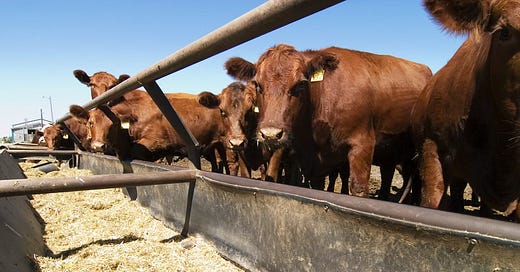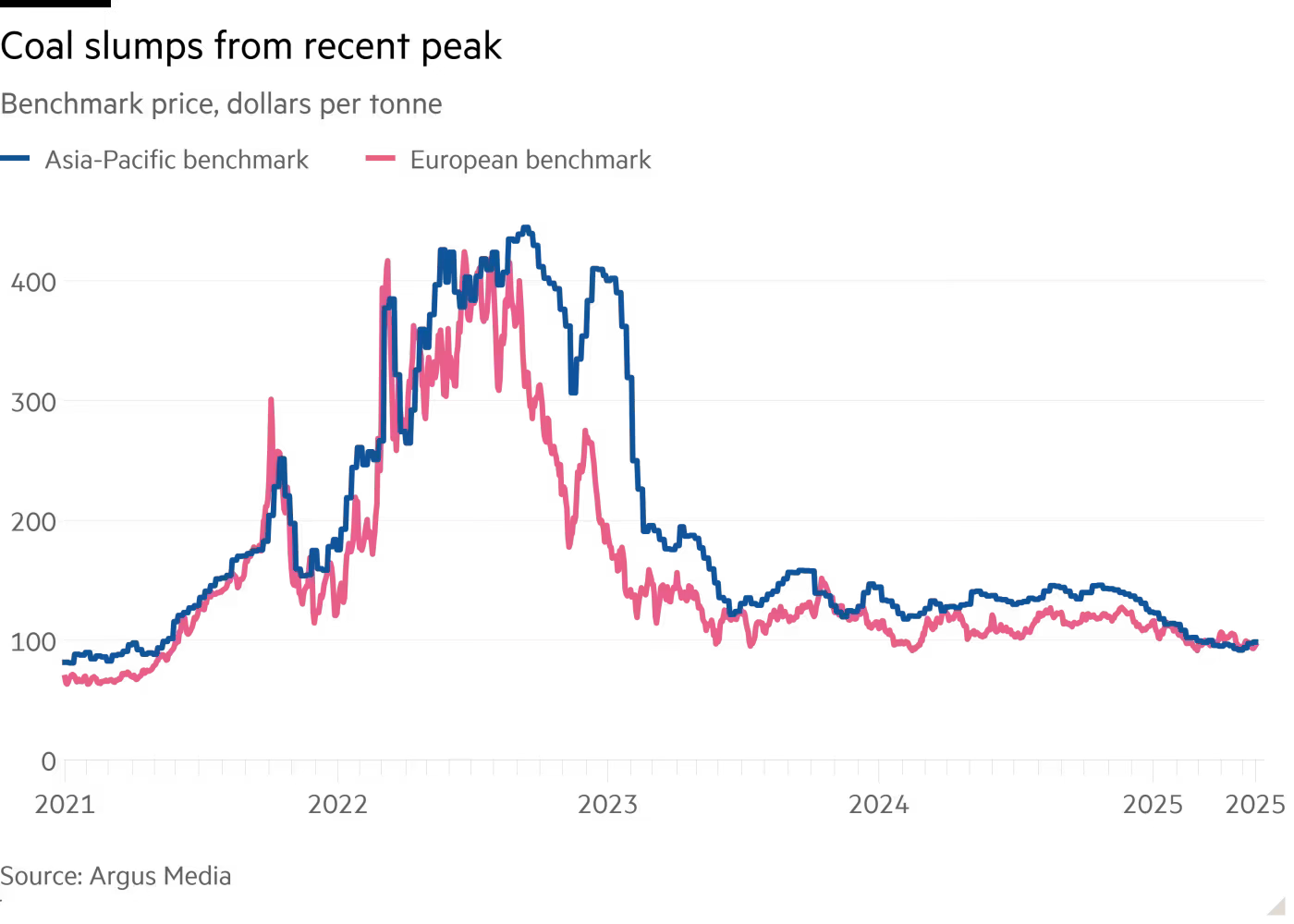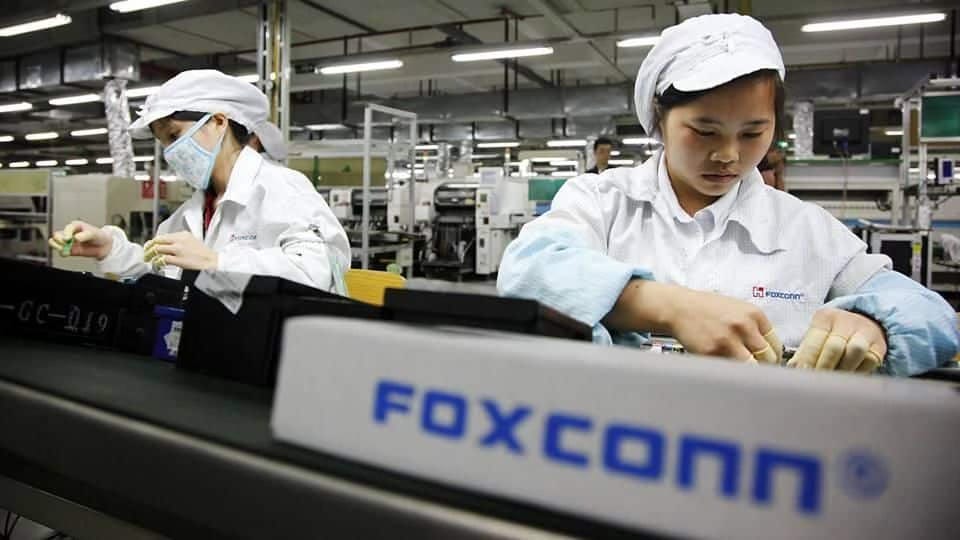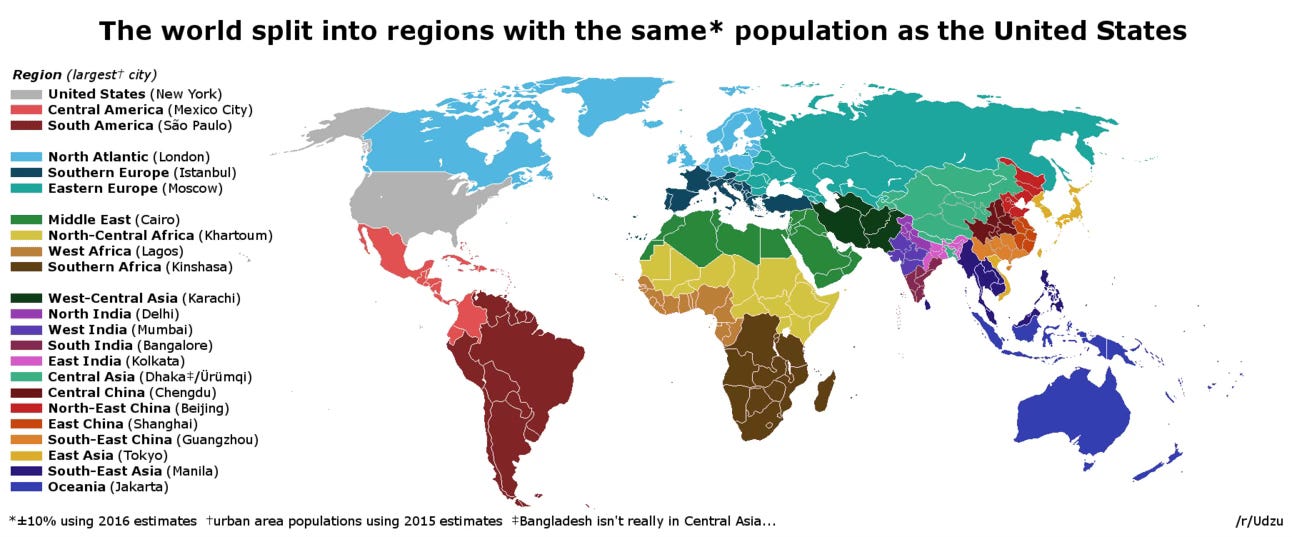Beef Prices Through the Roof
Cattle being fattened at a feed lot in Saskatchewan. The price rise starts here.
Farmers in western Canada and the parts of the United States are dealing with the same dry weather. They are reducing their herds. Economics 101, fewer cattle mean higher prices. The price of beef is 50% higher than it was five years ago.
This hasn’t stopped North Americans from eating steak and hamburger. High protein diets are all the rage and there is no better way to pack on the protein than this.
Noom advertises: High protein diet, Change your Life in 16 weeks.
A World Glut of Coal
Thermal coal, the type seen above to generate electricity in China, is at a four year low. China is producing so much coal it has driven down world prices. This even as demand for coal rises as electricity is needed for the summer air conditioning season.
Here is a chart from the Financial Times.
Can the Iphone be Made in the USA?
Yes, but it would cost as much, $3,500 in the US, maybe more in Canada. Is demand so elastic that people would pay that much for a smart phone? Here is the reasoning from the tech website, CNET:
“The tech giant has also moved some US iPhone production from China to India, which currently has a lower tariff rate. However, Trump called out Apple CEO Tim Cook to instead move iPhone production to the US. Most experts consider this an unrealistic demand, especially in the short term, because of higher labor and production costs in the US. Estimates have suggested that a US-made iPhone would cost as much as $3,500.”
And there is an odd reason why China is a better place to make iPhones. The small fingers of many Chinese women. This from the New York Times, which one would think would be wary about wading into physical traits by ethnic group.
Here is the New York Times on the delicate subject of small Chinese hands:
What does China offer that the United States doesn’t?
Small hands, a massive, seasonal work force and millions of engineers.
Young Chinese women have small fingers, and that has made them a valuable contributor to iPhone production because they are more nimble at installing screws and other miniature parts in the small device, supply chain experts said. In a recent analysis the company did to explore the feasibility of moving production to the United States, the company determined that it couldn’t find people with those skills in the United States, said two people familiar with the analysis who spoke on the condition of anonymity.
The Times article said Apple found it couldn't make desktop computers in the United States because the people making them walked off the job before the next shift arrived. And Apple had trouble finding tiny screws to put the product together.
Here is Steve Jobs with the first iPhone in 2007. He said it would change the world, and it did. As it says on the box, designed in California, made in China.
President Trump wants iPhones made in the USA. Steve Jobs answered this question 14 years ago. In 2011, President Obama asked Jobs the same thing : “What would it take to make iPhones in the United States?”
Jobs answered: “Those jobs aren’t coming back.”
The New York Times story back then gave the example of how a small change needed to be made to the phone at the last minute. The Chinese managers had 8,000 workers back in the middle of the night.
An article in Inc. had this comment.
“Can you imagine American workers agreeing to be awoken in the middle of the night to start clicking glass into phone frames? Probably not, and recent surveys support this intuition.”
Maybe the iPhone will be made in the USA. It might create a few jobs, but it will also create a lot of unhappy voters who have to shell out $3,500 for a smartphone.
Odd Maps and Demographics
Crowded Europe
The Netherlands is the most crowded country in Europe. A Dutch engineer I knew once calculated that if the Canadian province of Saskatchewan had the same population density as The Netherlands you could squeeze the world population in.
Essay of the Week
Dian Cohen wrote books and newspaper columns about retirement and advised audiences about life after work on hundreds of radio and television broadcasts. But while she may have known the secrets to a happy retirement, she was happier to keep on working. She wrote her final column just before her death on May 5 at age 92.
“This is my last column. I’ve loved every minute of writing them and answering your questions. My curiosity about how the financial world works has driven my efforts to provide you with insights. I learned early on that politics plays an outsized role in finance, but it’s not the only factor,” began the column, which appeared in the May 12 edition of The Record, a daily newspaper in Quebec’s Eastern Townships.
Her parting wisdom included saving at an early age, making a budget and staying physically active.
“For Dian, work was a big part of what made life worth living,” said Dr. François Lamontagne, a medical researcher and professor at the University of Sherbrooke who worked with Ms. Cohen on volunteer projects.
Ms. Cohen was an economist who spoke and wrote in plain English that people could understand, explaining the workings of the economy, markets and business long before business television became popular.
“In the mid-1980s on Canada AM we started using Dian for the occasional explainer,” said Eric Morrison who produced the program at the time. “She was so good at making economics understandable and business interesting that we soon gave her a regular business slot every morning. She was always engaged, upbeat and positive to work with even with the 5 a.m. wake-up calls for a 6 a.m. start, which could get to be a grind for anyone.”
Part of the time, she broadcast her CTV slot from New York, where she was a visiting fellow at the Americas Society. A car would pick her up at 4 a.m. to take her to a studio. Her New York experience led her to help found the International Institute for Sustainable Development. She was part of the delegation to the first Earth Summit in Rio in 1992.
A trained economist, Ms. Cohen realized her strength wasn’t in the world of academia but in explaining complex concepts to ordinary people.
“I knew I wasn’t going to be the next John Maynard Keynes, but I realized I’m really good at communications,” Ms. Cohen said in a 2015 article about her in The Record. “I took the theoretical stuff and made people understand it.
“For as long as I’ve been an adult, I’ve wondered why we don’t teach money matters to children. We all learn how to read, we should all learn how far a dollar goes.”
Her articles appeared in Canadian newspapers and magazines; for many years she was the Canadian correspondent for The Economist, the prestigious British magazine. She wrote seven books.
Some of Ms. Cohen’s economic advice in No Small Change, a book she co-wrote in the early 1990s, sounds as if it could have been spoken during the 2025 federal election campaign.
“What we have tried to show [in the book] is how to take a moderately competitive, low-growth, high-cost country and turn it into a world leader,” Ms. Cohen said in an interview with Statistics Canada in the summer of 1993. “It is not impossible for Canada to get a big jump on the rest of the world, because we have a lot of world-class intelligence in the country.”
Winnipeg seems to produce an outsized number of well-known economists, from Sylvia Ostry, formerly the chief statistician at Statistics Canada among other achievements, to Ms. Cohen.
Born Dian Nusgart on July 11, 1932, she was the daughter of Hyman Nusgart, a grain broker, and the former Bernice Stern a homemaker. After attending public schools in Winnipeg, she studied economics and political science at the University of Toronto, receiving her bachelor’s degree, then did further studies at McGill University.
She married Maxwell Cohen, and they had three daughters. The couple divorced but she kept her married name.
Along with her media work, Ms. Cohen also operated an economic consultancy, and she was in demand as a board member on several companies, including Canadian Pacific, Sun Life and Dorel Industries.
In 1975, Ms. Cohen bought a property in Hatley in Quebec’s Eastern Townships and kept a residence in Montreal while she was broadcasting and doing consulting work. She moved to the Townships full time around 1992. She was extremely active in the community and was the driving force behind the Massawippi Valley Health Foundation, a public clinic in the nearby town of Ayer’s Cliff.
“It provides primary healthcare and illness prevention in an underserved rural area,” her family death notice said.
“Early on, Dian was the only player on the ice. It was a one-woman show, getting around the administrative barriers to opening a clinic. She succeeded against all the odds,” Dr. Lamontagne said. He also worked with Ms. Cohen on a project on advanced care planning.
“Earlier in her life she spent a lot of time in an ICU, so she had lived experience. We wrote a scientific article together,” said Dr. Lamontagne. “Her intellectual fire never burned out. We worked together until she died.”
Ms. Cohen was named a member of the Order of Canada in 1993.
“Economist, broadcaster and author, she has enlightened Canadians by demystifying the workings of the economy and the business world for more than 25 years,” the citation reads. “She is an outstanding volunteer who has also donated a significant amount of her time to the YMCA and the Public Policy Forum.”
She was also a made a member of the Order of Manitoba and was the recipient of three honorary degrees.
Ms. Cohen also had her whimsical side. She had, according to her family, “a passion for making preserves and pickles.” She also knitted animals, including penguins, which won prizes at local fairs.
Ms. Cohen leaves her three daughters, Lisa, Nina and Tamara; and one grandchild, Michael Rivard.












